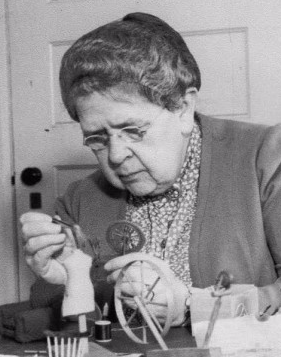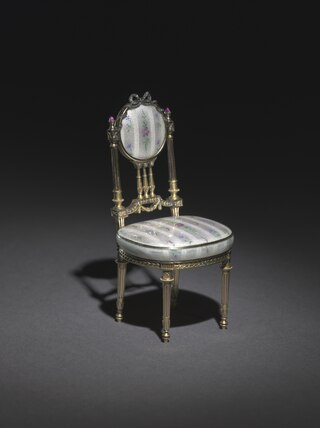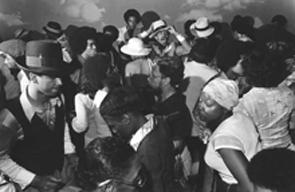
Frances Glessner Lee was an American forensic scientist. She was influential in developing the science of forensics in the United States. To this end, she created the Nutshell Studies of Unexplained Death, 20 true crime scene dioramas recreated in minute detail at dollhouse scale, used for training homicide investigators. Eighteen of the Nutshell Studies of Unexplained Death are still in use for teaching purposes by the Maryland Office of the Chief Medical Examiner, and the dioramas are also now considered works of art. Glessner Lee also helped to establish the Department of Legal Medicine at Harvard, and endowed the Magrath Library of Legal Medicine there. She became the first female police captain in the United States, and is known as the "mother of forensic science".

A dollhouse or doll's house is a toy home made in miniature. Since the early 20th century dollhouses have primarily been the domain of children, but their collection and crafting is also a hobby for many adults. English-speakers in North America commonly use the term dollhouse, but in the United Kingdom and other English-speaking countries the term is doll's house. They are often built to put dolls in.

Queen Mary's Dolls' House is a dollhouse built in the early 1920s, completed in 1924, for Queen Mary, the wife of King George V. It was designed by architect Sir Edwin Lutyens, with contributions from many notable artists and craftsmen of the period, including a library of miniature books containing original stories written by authors including Sir Arthur Conan Doyle and A. A. Milne.
Titania's Palace is a miniature castle (dollhouse) that was hand-built in Ireland by James Hicks & Sons, Irish Cabinet Makers, who were commissioned by Sir Nevile Wilkinson from 1907 to 1922. Wilkinson's daughter Guendolen claimed to have seen a fairy running under the roots of a tree, in a wood beside their home at Mount Merrion House. It is said that Guendolen felt sorry for the fairies, who have to live in caves.

Womanhouse was a feminist art installation and performance space organized by Judy Chicago and Miriam Schapiro, co-founders of the California Institute of the Arts (CalArts) Feminist Art Program and was the first public exhibition of Art centered upon female empowerment. Chicago, Schapiro, their students, and women artists from the local community, including Faith Wilding, participated. Chicago and Schapiro encouraged their students to use consciousness-raising techniques to generate the content of the exhibition. Together, the students and professors worked to build an environment where women's conventional social roles could be shown, exaggerated, and subverted.

Miniature art includes paintings, engravings and sculptures that are very small; it has a long history that dates back to prehistory. The portrait miniature is the most common form in recent centuries, and from ancient times, engraved gems, often used as impression seals, and cylinder seals in various materials were very important. For example most surviving examples of figurative art from the Indus Valley civilization and in Minoan art are very small seals. Gothic boxwood miniatures are very small carvings in wood, used for rosary beads and the like.

The Art Institute of Chicago in Chicago's Grant Park, founded in 1879, is one of the oldest and largest art museums in the world. Recognized for its curatorial efforts and popularity among visitors, the museum hosts approximately 1.5 million people annually. Its collection, stewarded by 11 curatorial departments, is encyclopedic, and includes iconic works such as Georges Seurat's A Sunday on La Grande Jatte, Pablo Picasso's The Old Guitarist, Edward Hopper's Nighthawks, and Grant Wood's American Gothic. Its permanent collection of nearly 300,000 works of art is augmented by more than 30 special exhibitions mounted yearly that illuminate aspects of the collection and present cutting-edge curatorial and scientific research.

A room box is a display box used for three-dimensional miniature scale environments, or scale models. Although the name would suggest room boxes generally only represent typical rooms such as those found in houses or other buildings, room boxes are used for all sorts of environments – exterior views as well as interior ones, realistic ones as well as fantastical ones. While some miniaturists concentrate their efforts specifically on room boxes, many use them to take a break from larger projects, such as dollhouses or miniature villages, to create a smaller environment on a different theme. A room box can be tailored to one’s interests or mirror an important step in life - for example, a bakery or restaurant scene might be created by or for a baker or cook, and a wedding dress storefront might be created for a bride to be or as a reminiscence of one's wedding. Making a room box is often a first step to learning new techniques in miniature making; such projects are popular at miniaturists' events where attendees have only 1–2 days to make and finish a project. Once techniques are perfected in these smaller settings, craftspersons and hobbyists often reapply them to larger projects.

The Knoxville Museum of Art (KMA), is an art museum in Knoxville, Tennessee. It specializes in historical and contemporary art pieces from the East Tennessee region. According to its mission statement, the museum "celebrates the art and artists of East Tennessee, presents new art and new ideas, educates and serves a diverse community, enhances Knoxville’s quality of life, and operates ethically, responsibly, and transparently as a public trust."

The Nutshell Studies of Unexplained Death are a series of nineteen intricately designed dollhouse-style dioramas created by Frances Glessner Lee (1878–1962), a pioneer in forensic science. Glessner Lee used her inheritance to establish a department of legal medicine at Harvard Medical School in 1936, and donated the first of the Nutshell Studies in 1946 for use in lectures on the subject of crime scene investigation. In 1966, the department was dissolved, and the dioramas went to the Maryland Medical Examiner's Office in Baltimore, Maryland, U.S. where they are on permanent loan and still used for forensic seminars.
Laurie Simmons is an American artist, photographer and filmmaker. Since the mid-1970s, Simmons has staged scenes for her camera with dolls, ventriloquist dummies, objects on legs, and people, to create photographs that reference domestic scenes. She is part of The Pictures Generation, a name given to a group of artists who came to prominence in the 1970s. The Pictures Generation also includes Cindy Sherman, Barbara Kruger, and Louise Lawler.

Michael Abramson was a Chicago photographer who produced a large body of artistic and commercial photography.

Narcissa Niblack Thorne was an American artist known for her extremely detailed miniature rooms. Her works depict historical interiors from Europe, Asia and North America from the late 13th to the early 20th century. The Thorne rooms are honored with dedicated exhibits in the Phoenix Art Museum, the Knoxville Museum of Art, and the Art Institute of Chicago, where a special wing was built to house them.

Astolat Dollhouse Castle is a museum-quality dollhouse, which was appraised as "the most valuable dollhouse in the world," at $8.5 million in 2015.

Petronella Oortman was a Dutch woman whose elaborate dollhouse is part of the permanent collection of the Rijksmuseum in Amsterdam.
Edwin Hill Clark was a Chicago architect best known for designing public buildings and private residences. His buildings, many of which are located along Chicago's North Shore, reflect a wide range of styles from English Tudor to Mediterranean and Spanish. Among his best known works is the Brookfield Zoo in Brookfield, Illinois, which was the first zoo in the United States to display animals in simulated natural environments rather than behind bars. He is also known for his work on the Thorne Rooms, commissioned by Narcissa Niblack Thorne, which are on permanent display at the Art Institute of Chicago.

Josefine Pola Stout was an American designer best known for creating fine woolen fabrics. Born in Stryj, she studied with Josef Hoffmann at the Kunstgewerbe Schule in Vienna, and designed for the Wiener Werkstätte before she immigrated to the United States in 1925 with her first husband, architect and designer Wolfgang Hoffmann. Wolfgang and Pola Hoffmann became a prominent interior design team that contributed to the development of American modernism in the early 20th century. They dissolved their successful partnership in 1932, when she married popular mystery author Rex Stout. Pola Stout was an influential textile designer after her second marriage. She was executor of Rex Stout's literary estate after her husband's death in 1975.

Ann Toebbe is an American contemporary artist who has had solo exhibitions at the Museum of Contemporary Art, Chicago, The Saatchi Gallery, Steven Zevitas Gallery, Monya Rowe Gallery, and Tibor de Nagy Gallery. Based in Chicago, she is best known for creating meticulously designed paintings and collages that depict the interiors of domestic life. In 2015, Vulture magazine art critic Jerry Saltz named one of Toebbe's exhibitions one of the year's 10 best. Toebbe has been featured in articles in Artforum, The New York Times, NY Magazine, The Boston Globe, The Chicago Tribune, Art in America, and Hyperallergic, among others.
Meyric R. Rogers (1893–1972) was an Anglo-American curator and design historian.
Sherry Brody was an American artist and pioneering member of the feminist art movement. Brody is known for her work on the Womanhouse project. Her sculpture, The Dollhouse, is in the Smithsonian Museum of American Art collection.
















